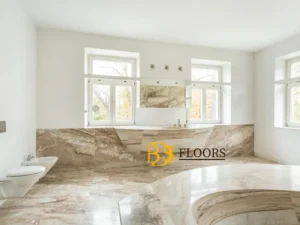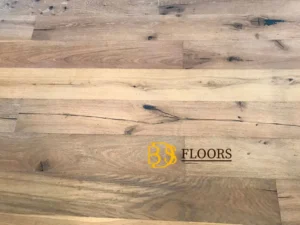How to Choose & Install Hardwood Floors: A Complete Guide
A thorough guide on selecting and installing hardwood floors is crucial for homeowners embarking on a renovation project, as it serves as the foundation for the rest of the design. Although there are numerous flooring options available, hardwood is widely regarded as the benchmark material.
However, not all hardwood floors are the same, and picking the right product involves more than just choosing a color that appeals to you. Other factors, such as appearance and durability, can significantly affect the overall performance and visual appeal of the flooring.
When selecting hardwood flooring, one of the first decisions to make is whether to choose solid or engineered flooring. Solid hardwood planks are the traditional option and are still widely available, but engineered flooring has become popular due to its thinner top layer of hardwood bonded to other layers that prevent the floor from shifting during natural expansion and contraction cycles. Engineered flooring is especially advantageous for basements and apartments with concrete subfloors, as it can be glued directly to the concrete or a soundproofing mat without raising the floor’s height or interfering with existing doors. It’s also suitable for installation over radiant heat.
However, it’s essential to choose carefully when it comes to engineered flooring, as some products have top layers that are too thin to be sanded and refinished in the future. High-quality engineered flooring features a thicker layer of usable wood, providing the same refinishing options as solid hardwood flooring, which can only be refinished using the part above the tongue and groove.
Although engineered flooring has its advantages, some homeowners still prefer the tangible quality of solid hardwood. As Miller puts it, “there’s something about a solid hardwood that’s a tangible difference. You can feel it underfoot, and it’s quieter.” Once you’ve made your choice, be sure to learn how to properly clean hardwood floors to maintain them.

When selecting hardwood flooring, you’ll also need to decide between prefinished or site finish options. Prefinished wood arrives with the stain and topcoat already applied, making it easy to coordinate with other design elements and quicker to install. On the other hand, site finishing allows for greater customization and control over the final product’s stain and sheen. Unfinished flooring is sanded after it’s nailed down and finished as a single, continuous plane, resulting in a smoother finish. While prefinished flooring is a safer choice, site finishing can add that extra level of detail and personalization that appeals to many homeowners and designers.
- Choose between Solid or Engineered Flooring Solid hardwood flooring is a traditional option that remains available today, while engineered flooring is made up of a thinner top layer of hardwood that is bonded to other layers to prevent shifting during natural expansion and contraction cycles. Engineered flooring offers installation advantages over solid wood in areas such as basements and apartments with concrete subfloors, and it is also suitable for installation over radiant heat. However, some engineered floors have thin top layers that cannot be sanded and refinished in the future.
- Decide between Prefinished or Site Finish Prefinished flooring arrives with the stain and topcoat already applied, which can help with color coordination and installation time. On the other hand, site finishing allows for more customization and a smoother final product.
- Choose the Type of Finish Finishing products range from penetrating oil to oil-like hybrids to polyurethane finishes. Most finishes fall into two categories: oil or polyurethane. Oil finishes penetrate the wood and create a natural, soft, and matte look and feel, while polyurethane creates a hard topcoat that is more resistant to wear and tear.
- Consider Wood Types Oak is a popular and durable hardwood option that takes stain well, while white oak is especially popular for its lack of pinkish tones. Walnut has a deep color that is ideal for darker finishes, and it is a natural choice for achieving a richer, warmer tone. Other North American hardwoods include hickory, cherry, maple, and ash, and the choice largely comes down to personal preference in terms of color and grain.
- Select Your Grain Pattern When logs are cut, they are done in three different ways which result in three distinct grain patterns: plain-sawn, rift-sawn, and quarter-sawn. Plain-sawn boards produce a classic wood grain with wavy patterns known as cathedrals. “It’s exactly what you imagine when you think of wood grain,” says Caroll.
On the other hand, rift-sawn boards have a long, linear, and uniform grain without cathedrals. Quarter-sawn boards appear similar to rift-sawn ones, but they have extra irregular figuring with shimmering, almost three-dimensional rays that spread across the plank. “This can be desirable or undesirable, depending on what you’re seeking,” Caroll explains.
In most cases, hardwood flooring is sold as plain-sawn or as a mixture of rift-sawn and quarter-sawn boards. “The combination is good because it provides some of that figuring without overdoing it,” Jones says. Nevertheless, you can obtain exclusively rift-sawn or quarter-sawn wood if desired.

When it comes to wood grain, Miller says there’s no right or wrong. “It all depends on the application and what you want. We might use plain-sawn in a more rustic property, and quarter-sawn in a city setting to add some life.”
- Determine the Width of Planks While hardwood flooring used to be mostly installed in two- to three-inch strips, wider planks are more common now. “There’s a feeling of luxury and expense associated with wider planks,” Miller says. “Once you exceed the norm, it starts to feel special.” That’s why, she adds, “our typical specification is four to six inches wide, depending on the room’s size and usage.” Generally, the wider the room, the wider the plank they’ll choose.
At LV Wood, “our standard wide-plank floor is seven inches,” Caroll says, and they offer even wider sizes. However, he notes that wider planks aren’t just more luxurious-looking, they’re also more expensive. “The wider you go, the more costly it gets.”
While a floor made up of wide planks will have fewer seams than one composed of thin strips, it’s important to keep in mind that those seams may become more visible as the wood expands and contracts. Since changes in the wood aren’t distributed across as many boards, the movement may appear exaggerated.
Guide to Installing Hardwood Floors
Required Tools and Materials
Before beginning the installation process, it’s essential to ensure that you have all the necessary tools and materials for your specific hardwood flooring type. “
- Determine the Correct Installation Method
The first step is to establish the correct installation method for your chosen flooring type. The installation methods depend on the hardwood product’s thickness, width, and construction and where it is being placed. Typically, solid hardwood flooring is attached to a wood subfloor using nails or staples. The installation of engineered hardwood can be achieved by mechanical fastening, gluing, or installed as a ‘floating floor,’ depending on the product.” It’s important to note that solid hardwood should not be installed below ground level.
To begin installing the flooring, start by laying down the underlayment if necessary. Lay the floor pieces parallel to the longest wall in the room, starting from the left side and working towards the right with the small tongue side facing towards you. Be sure to use spacers between the boards and the walls to allow for expansion and follow the manufacturer’s instructions for the appropriate installation method.
If you plan to use a pneumatic nail gun, drill pilot holes and face-nail the first few rows until there is enough space for the nail gun. Keep in mind that the boxes or bundles of flooring may vary slightly in color, so it’s best to mix boards from different boxes to achieve a more random look and prevent lighter or darker patches from appearing on the finished floor.
When it comes to adding the finishing touches, it’s important not to cut corners. The finishing details can either make or break the success of a professional-looking job. You may need to cut boards lengthwise for the last row and trace for contours to be cut and fitted according to the installation guide. Once all rows are installed, remove the spacers and attach trim and moldings to complete the project.
We advises that installing hardwood floors with nails or glue can be difficult even for experienced DIY enthusiasts. Given that hardwood floors are a significant investment, it’s crucial to get the installation right, and this requires time, precision, and expertise. If you’re unsure, it’s best to hire a professional installer to ensure the job is done correctly the first time.
To acclimate solid hardwood flooring, it’s important to let the packaged boards sit in the room where they will be installed for several days, with the cartons open and raised off the ground. This allows the wood’s moisture content to adjust to the conditions in the room. On the other hand, engineered flooring does not require acclimation, but it’s best to store it in the environment before installation. It’s also essential to keep the humidity level of your home at between 35 and 55 percent or follow the manufacturer’s recommendations to reduce any movement within the wood flooring later.
Before starting the installation process, read the detailed installation instructions that come with your product carefully. We recommends watching a few installation videos to understand how it’s done. Gather all the tools listed in the instructions and ensure that the subfloor is clean, dry, and flat. If you’re installing over an existing floor, ensure that the doors can still open and close, and appliances are flush with countertops. Most hardwood flooring can be installed over existing ceramic tile, marble, or terrazzo with proper underlayment or adhesives (as per the manufacturer’s recommendation). For nail-down applications, flooring can be installed over existing sheet vinyl or vinyl tile if the subfloor meets minimum requirements, and the fastener penetration is not significantly diminished.
If you’re installing over existing wood floors, make sure not to sand any surfaces that contain asbestos or are coated with lead-based finish or paint. After addressing any issues, measure your room and add 5 percent to the finished square footage for cutting allowance before snapping chalk lines to balance the room. Remove any millwork or trim that you’ll reuse, and remove the flooring if necessary. Finally, if you’re nailing the floor, mark the wall to indicate the position of the floor joists.







